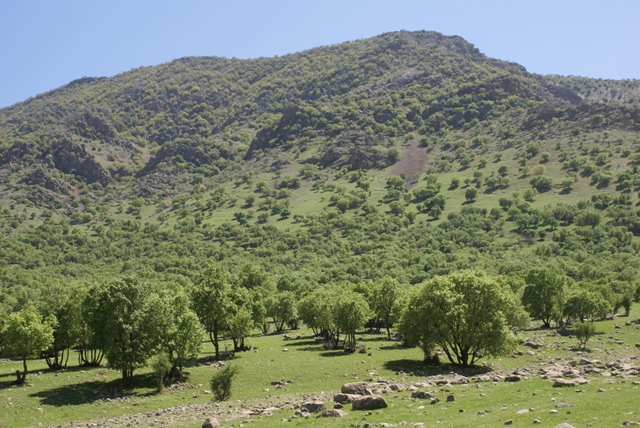My Persian 3 solutions to strengthen the forests of Zagros / why the oaks were killed by the pest

According to the economic reporter of Fars news agency, the invasion of oak leaf-eating and bud-eating pests in the forests of Zagros has been very newsworthy in the past days because this uninvited pest invaded 60 thousand hectares of Zagros forests and affected the ecosystem of these forests and consequently the economy of the region. has given, the pest has eaten the leaves of the trees and has taken the greenness of the forest. This is a very bad situation that can cause any big fires.
In fact, forests are the breathing lungs of the earth and are a great barrier against fine dustAir and wind pollution is harmful for agriculture, on the other hand, it conserves water and soil and is very important for ensuring food security.
While the country’s forests and trees are under serious threat due to various reasons of climate change, drought and human interventions, the preservation of Zagros forests is very important for the country.
The Zagros forests cover an area of 6 million hectares from West Azerbaijan in the northwest of the country to Kohgiluyeh and Boyer Ahmad, Fars and Khuzestan in the south. The bud-eating and leaf-eating pest of the oak leaves them half alive by eating the leaves of these trees and weaves a net around itself, which from time to time uses the leaves of the green trees of these forests, but on the other hand, it makes this forest with intertwined trees weaker day by day. .
In the 6 million hectares of Zagros forests, 2 thousand 372 identified plant species, 61 mammal species, 27 fish species, 167 bird species and 37 reptile species live in Zagros forests.
Also, 180 tree and shrub species, more than 25 forest and pasture species, 70% of nomads and 50% of the country’s livestock are located in the Zagros region, so that this ecosystem is considered as a strategic region in the country.
The average rainfall in Zagros forests is about 800 mm per year and provides more than 50% of the country’s water. This forest area includes 40% of Iran’s forests.

Among the 11 Zagros provinces, Fars, Lorestan and Khuzestan have the first to third ranks in the area of forest and tree habitats, and oak covers about 70% of the forest species in Zagros.
About the cause of the attack of this pest on the forests of Zagros, as well as the progress of the pest and the steps to deal with it Pure Shabanian, The deputy of forest affairs of the country’s forest organization, to saidWego we sat.
According to this official working group The Zagros forest restoration committee was formed under the chairmanship of the first vice president and with the presence of almost all the ministers. working group He holds meetings with the ministers and governors of Zagros every three months, and the issues and problems of these forest areas, as well as solutions to these problems and dealing with this pest, are supposed to be on their agenda. The government has approved an amount of 50 billion tomans for the rapid control of this pest. Although It has not been assigned yet; The Zagros forest restoration plan has been handed over to the government, which is supposed to plant 100 trees per hectare every year, and we have predicted that 50 thousand billion Tomans will be needed for this plan in 10 years.
This official also said: At the beginning of the work, we thought that the pest would not progress and would disappear naturally, as we had the same experience in previous years, but over time the pest progressed; Now the control plan is to use a biological method and a substance called BT (from a type of bacteria used) for control, that is, to spray between infected and healthy spots to prevent the spread of the pest to other areas.
In the following, you will read the interview of Fars with the deputy of forest affairs of the country’s natural resources and watershed management organization.
* Why Zagros forests are weak against the oak bud-eating pest
Fars: The oak bud-eating pest has been affecting the forests of Zagros for some time, what is the reason for the spread of this pest in this region?
Shabanian: There are 6 million hectares of Zagros forests, which control the water cycle and infiltration and, in fact, provide the economy of this region. 40% of the country’s water is supplied from the Zagros forests, and for this reason, it plays an important role in reducing environmental effects. fine dust, has greenhouse gases and carbon composition. About 60 tons per hectare of forest fine powder but in the past years, due to human and natural factors, the forests of Zagros have aged, and for this reason, they are weak against pests and diseases. So that the oak bud-eating insect, which was once a member of this ecosystem, has now appeared as a pest in front of oak forests. Natural factors such as successive droughts have weakened the forests of this region. But among this, human factors played a more destructive role, such as the excessive use of warLchanges in land use and excessive grazing and cutting of trees over the years have caused the oak forests of Zagros not to be upright enough to withstand weak pests such as the oak bud-eating pest.. That’s why the insect or the pest has invaded and destroyed the lives of the oak forests, they are looking for food. They feed the leaves of the trees and every day these trees become weaker and weaker.
* Solutions to combat the oak bud-eating pest in Zagros/Zagros have been published
Fars: What strategies have you used to deal with this pest in Zagros forests?
Shabanian: We follow three short-term, medium-term and long-term solutions; First, we are looking to control this pest in the short term. We do not intend to use any chemical poisons, but we control this pest by biological means, because we are not looking for the complete destruction of this insect, because its existence is necessary in the ecosystem. In the medium-term phase, we are trying to increase the canopy and cover of the Zagros forests by increasing reproduction, sowing and planting seedlings, in order to prevent the aging of these forests. Abelief We know that the main reason for the invasion of these pests is the aging of the forest and its weakening over the past many yearsbut in the long term we will try to get help from people’s support and carry out regular biological monitoring to determine the condition of the forests.
Fars: As you said, the main reason for the spread and outbreak of this pest was the aging and weakening of the forests, but its rejuvenation requires a long-term plan and sufficient credit. Do you have a comprehensive plan in this field?
Shabanian: Yes, this pest was identified in 1351 and 1352 and it had an outbreak at times, but this time the outbreak of this pest was severe. It has affected 60 thousand hectares of Zagros forests, 70% of which are oaks, but we don’t think that the whole tree will be destroyed by eating the leaves of these pests, but that these trees will grow again next year, even some Experts believe that in the current drought conditions, eating the leaves of trees increases their durability because the level of plant photosynthesis and its interactions are reduced.
Currently, the government has approved an amount of 50 billion tomans for the rapid control of this pest. Although It has not been allocated yet, but we do not have a problem in this regard, and we believe that the government will support in this regard, and the equipment is going to be sent to the provinces. Important nowthe most The center of this pest is in Kohgiluyeh and Boyer Ahmad, which has affected 26 thousand hectares of forests in this region, and about 9 thousand hectares of forests in Khuzestan region and 6 thousand hectares in Fars province are affected by this pest.
* Encouraging the locals to deal with the oak bud-eating insect
Fars: What is your current plan to fight this pest?
Shabanian: According to the meetings we had with experts, foresters and ecologists in Tehran and the provinces of the country, and the visit that was made to the infested areas by the officials of the agriculture sector, we came to the conclusion that first of all, biological methods must be used for the fight, and in this method BT (combination Biological Bacillus bacteria) is used and it will be used at the border of infected and healthy forests to prevent the development of the pest. In addition to that, the combined solution of using light traps, mechanical collection of insects is used. We informed the people of the regions that they will receive 20 thousand Tomans for the delivery of one kilo of this insect. We have also requested cooperation from knowledge-based companies, but all our efforts in the medium and long-term plans are to return the balance to the forest, and the problem we are seeing now is due to the disruption of this balance over the past years.
Fars: In order to restore balance to the forest, comprehensive and long-term plans are needed, which must be presented by you. Did you have a plan in this regard? Have you done a credit estimate?
Shabanian: We have prepared a document for reforestation of Zagros forests, which we are implementing as a pilot in Khuzestan. Based on that, 100 trees are supposed to be planted per hectare every year, and we have predicted that 50 thousand billion tomans will be needed in this plan over 10 years, and in this case, in addition to reviving these forests, sustainable development will actually take place.
Fars: It seems that the time of your fight against this pest is a little late, this pest should have been fought when it was in the beginning of attacking the forest, when the pest reached a critical point, it is very difficult to contain and control it.
Shabanian: This pest had spread many times, and based on the consultation of experts and various meetings we had with them, we came to the conclusion that they will disappear naturally and will not cause any special problem for the forest, but over time, their spread will increase due to the droughts that There was more and it involved oak forests.
Fars: Explain why you didn’t use chemical poisons at the very beginning of the work to contain it at a smaller level and prevent it from spreading to other areas?
Shabanian: The use of chemical poisons in forests is not correct at all. The forest is an uncontrolled area and it is not like the garden and fields where poisons can be used in a controlled way, the forest is the habitat of all kinds of trees, plants, and animal species, the use of any chemical poisons can endanger their lives.
Fars: I don’t mean the use of chemical poisons on a large scale, but at the very beginning of the work and to stop the spread of this pest, which may have had an initial risk, but 60 thousand hectares of forest would not be affected by this pest.
Shabanian: In any case, we do not consider it advisable to use chemical poisons in the forest, and this is not only my opinion, but the opinion and consensus of experts.
* working group The Zagros forest restoration leadership was formed
Fars: Is there a special plan for the restoration of the Zagros forests at the macro-management level, which can be a national plan, or to fight against this pest?
Shabanian: working group The Zagros forest restoration management is chaired by the first vice president and with the presence of almost most of the ministers. this working group He holds meetings with the ministers and governors of Zagros every three months, and the issues and problems of these forest areas, as well as solutions to overcome these problems and to deal with this pest, are to be discussed in work order be them The main problem with this pest is that there are two types of oak leaf-eating and bud-eating pests; The oak borer is specific to cold regions and lives at altitudes above one thousand meters and has one generation, and fighting it is not a difficult task. But our main problem is related to the oak leaf eater, which lives in the tropics and has several generations, which is why it is very difficult to fight it. In a year we see different generations of insects, pupae and larvae. Different “ages” that show their life periods and in fact each one requires a special struggle, so in this season we see insects, pupae and larvae in the forests of Zagros.
Faris: Thank you for your time for this interview.
Therefore, the report of my Fars audience, by registering subjects with the titles “Urgent and scientific solution to the pest situation of Zagros oaks”, “Think of a solution for the new oak pest”, “Request for urgent measures to deal with the white butterflies of Zagros trees”, requested the follow-up of this issue.
end of Payam/T 101

